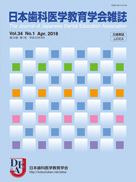Volume 32, Issue 3
Displaying 1-10 of 10 articles from this issue
- |<
- <
- 1
- >
- >|
-
2016Volume 32Issue 3 Pages 124
Published: 2016
Released on J-STAGE: December 14, 2018
Download PDF (100K)
-
2016Volume 32Issue 3 Pages 125
Published: 2016
Released on J-STAGE: December 14, 2018
Download PDF (86K)
-
2016Volume 32Issue 3 Pages 126-130
Published: 2016
Released on J-STAGE: December 14, 2018
Download PDF (2154K)
-
2016Volume 32Issue 3 Pages 131-132
Published: 2016
Released on J-STAGE: December 14, 2018
Download PDF (194K)
-
2016Volume 32Issue 3 Pages 133-136
Published: 2016
Released on J-STAGE: December 14, 2018
Download PDF (536K)
Original Article
-
2016Volume 32Issue 3 Pages 137-146
Published: 2016
Released on J-STAGE: December 14, 2018
Download PDF (340K) -
2016Volume 32Issue 3 Pages 147-154
Published: 2016
Released on J-STAGE: December 14, 2018
Download PDF (662K)
Report
-
2016Volume 32Issue 3 Pages 155-165
Published: 2016
Released on J-STAGE: December 14, 2018
Download PDF (3023K) -
2016Volume 32Issue 3 Pages 166-172
Published: 2016
Released on J-STAGE: December 14, 2018
Download PDF (2150K)
Survey
-
2016Volume 32Issue 3 Pages 173-183
Published: 2016
Released on J-STAGE: December 14, 2018
Download PDF (1058K)
- |<
- <
- 1
- >
- >|
